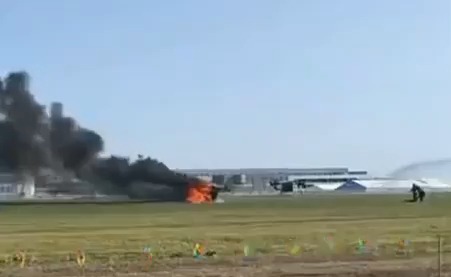THIS is the terrifying moment two flying cars smash into each other mid-air during an air show in China.
One pilot was injured as one of the vehicles plummeted to the ground, sparking a huge blaze.
Two flying cars crashed into each other during a rehearsal for an airshowX/@vani_mehrotra
Thick black smoke is captured billowing in the airX/@vani_mehrotra
Fire trucks rushed to the horror crashX/@vani_mehrotra
AlamyThe flying cars developed by Xpeng Aeroht, an arm of Chinese electric vehicle giant Xpeng[/caption]
Emergency services were called to reports of the horror incident in Changchun, the capital of northeast China’s Jilin province, this afternoon.
It’s believed this is the first time flying cars have ever crashed.
Video shows plumes of thick black smoke billowing from one of the cars as flames engulf the air.
While, fire trucks appear racing to the crash as onlookers watch in shock.
It’s understood the flying cars – developed by Xpeng Aeroht, an arm of Chinese electric vehicle giant Xpeng – crashed into each other during a rehearsal for an airshow due to “insufficient spacing”.
According to a company statement shared with CNN, one of the car’s “sustained fuselage damage and caught fire upon landing”.
Local authorities rushed to the scene and completed “on-site emergency measures” and confirmed no one was seriously hurt.
One of the firm’s employees, who hasn’t been named, revealed the pilots had been performing “high-difficulty” stunts.
The air show comes as China looks to grow its “low-altitude economy” – an industry which includes flying taxis, drones and other innovative air-bound vehicles.
Last year, a report by China Low Altitude Economic Alliance revealed that air traffic networks and ground facilities for flying vehicles will be largely completed in the next two to three years.
This infrastructure will enable the mass production and commercialisation of Electric Vertical Takeoff and Landing Vehicles – or eVTOLs – by 2026.
While current eVTOLs cost a hefty 10 million RMB (£1 million) – prices are expected to drop significantly by 2030.
A family-friendly, four-or five-seat flying car could cost between £200,000 and £300,000 (2-3 million RMB) making them more accessible in the luxury market.
Advancements in artificial intelligence and unmanned technology are key to this vision.
The report predicted widespread use of flying vehicles for logistics, agriculture, urban management, tourism, and emergency rescue operations.
And drone technology is also evolving rapidly.
Companies like Beijing-based i-Kingtec have developed fully autonomous drone garages capable of operating over vast areas.
These are already being used for tasks like power grid inspections and environmental monitoring.
As this industry takes off, safety and regulation are top priorities.
Anti-drone equipment is gaining attention, with technologies to detect and manage rogue drones around sensitive locations like airports and power plants.
Companies are also working with authorities to establish no-fly zones and ensure safe operations.
China is embracing a “golden decade” for its low-altitude economy, which includes drones and eVTOLs.
This sector is expected to grow to a staggering 3 trillion RMB (£326 billion) by 2030.
Ehang, a leader in the field, has already delivered nearly 300 EH216-S eVTOLs and recently completed a test flight using advanced solid-state batteries.
Other companies, such as Xpeng Aeroht, are targeting mass production by 2026, with prices starting under 2 million RMB.
Black smoke filled the airX/@vani_mehrotra

